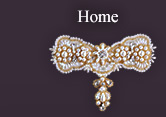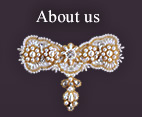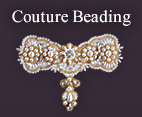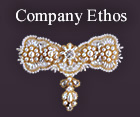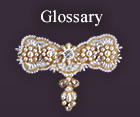Couture Embroidery Techniques:
Couture bead embroidery is traditionally called tambour beading. Tambour is a very ancient technique, and tambour embroideries were being imported from Gujarat as early as the 16th century by The East Indian Company, and the technique was also worked in Ireland, Switzerland and Saxony and was introduced to America in the early 1800’s. Tambour beading evolved from tambour thread embroidery and is named from the drum shaped frame originally used - ‘tambour’ is the french language word for drum.
In 1770, Charles St Aubin, Embroiderer to the French Court, wrote
about this new technique he called ‘La Broderie en Chainette
et au Tambour’, and the hook became the tool to rival the
needle. Tambour became a fashionable recreation for European
Society ladies in the late 1700’s and another technique
of the ‘gentle
arts’ to be used, like tatting had been, to display feminine
hands and virtues to calling admirers, as depicted in the painting
of The Ladies Waldegrave’ by Joshua Reynolds. Francois-Hubert
Drouais painted Madame Pomadour seated at her tambour frame holding
her hook, and this picture hangs in the National Gallery London.
We still sit at our frames in the same way holding the same type
of hook. We also use our hook to work applique, quilting, couching
and passementerie work, and can tambour onto finest silk to glove
leather. The beads are first strung onto the working thread,
and applied to the fabric by using a small hook, known as a tambour
hook. Even if you know nothing about this technique, you will
have seen a great deal of beading embroidered this way, as most
beaded couture, theatre and film costumes, and the Royal Wedding
dresses are tambour beaded, as were the beautiful 1920’s
beaded dresses and the great dresses of the Hollywood era. from
Edith Head to Bob Mackie. The same techniques are used by all
the great couture houses of Europe - Givenchy, Chanel, Valentino
and Versace amongst them.
Bead threading and wiring has, and is used, in many countries
and cultures, and again these are very ancient techniques.
Bead threading probably started when man first strung a pebble with a hole onto a length of sinew . There are spectacular historical and contemporary examples worldwide - Zulu, Xhosa, Native American, Russian, Chinese etc, and in Britain the early Stuart decorated boxes and Elizabeth 1’s garments show early examples, as do the beaded net dresses and face masks of the Egyptian mummies. We use the same threading and wiring techniques to embellish embroidery, and for jewellery, tiaras and head-dresses.
Please upgrade to the latest version of Flash Player.
Click here if you already have Flash Player installed.

